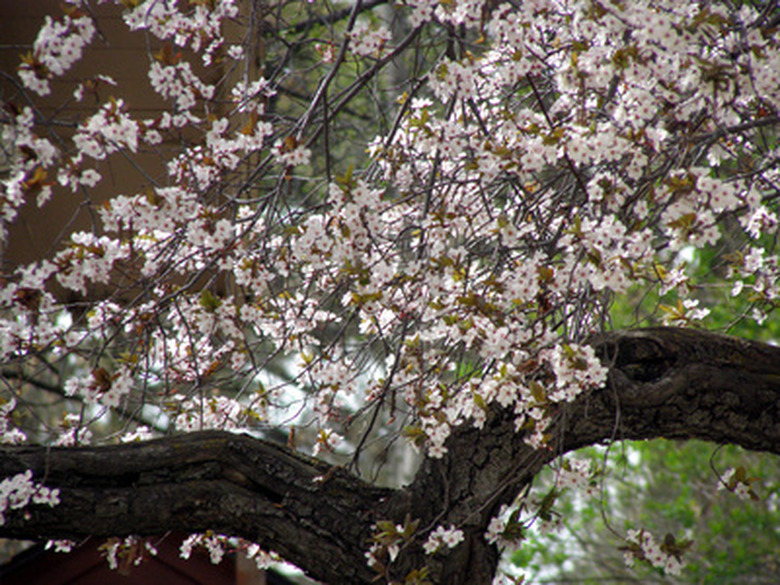The Sand Cherry Tree & Pests
The sand cherry tree is known for its purple leaves and white/pink spring blossoms. However, it does have its drawbacks. The sand cherry must be kept well hydrated, and it should be placed in a spot that receives full sun. It has a life expectancy of 10 to 15 years. The small fruit of the sand cherry will attract birds, which can be a nuisance to some homeowners, and the tree is susceptible to infestations from aphids, borers, tent caterpillars and webworms.
Tree Characteristics
The sand cherry tree is considered an ornamental/flowering tree. It can reach a height of from 7 to 10 feet tall, and a spread of 5 to 7 feet. The shape of the crown of the tree is round. Flowering occurs in late April through early May. It is a beautiful element in landscape design due to its purple leaves and spring blossoms. However, in addition to the various pests that can attack, the tree it is susceptible to diseases such as verticillium wilt, black knot, honey fungus, powdery mildew, leaf spot, cankers, bacterial leaf scorch and frost cracks.
- The sand cherry tree is known for its purple leaves and white/pink spring blossoms.
- The small fruit of the sand cherry will attract birds, which can be a nuisance to some homeowners, and the tree is susceptible to infestations from aphids, borers, tent caterpillars and webworms.
Signs of Insect Infestation
The signs of infestation are different for aphids, borers, tent caterpillars and webworms. If you notice distortion of new leaf growth, honeydew deposits and sooty mold, your tree has been infested by aphids. Symptoms of borers are quite different. You will notice sawdust-like excrement near one of their exit holes in the tree or on the ground, and sap at the wound in the tree. (Borer's holes can be round, oval or D-shaped.) The most obvious sign is of the tent caterpillars and fall webworms. Tent caterpillars build a bag-like tent structure in the branches of the tree that is very visible. Webworm nests are large webs that begin on the ends of the tree's branches; they infest a tree from August through September. As the caterpillars feed, the nests become bigger. A heavily infested sand cherry tree can be completely covered in nests, which can be up to 3 feet in length.
- The signs of infestation are different for aphids, borers, tent caterpillars and webworms.
- Tent caterpillars build a bag-like tent structure in the branches of the tree that is very visible.
Pest Damage
Aphids are sapsuckers, which means they suck the sap from the tree. This causes the leaves to curl up, wilt or die. Honeydew, a sticky substance, is their waste material. If there has been a severe infestation of aphids the honeydew will become a problem (if your tree is near a walkway or patio). Honeydew can cover sidewalks, patios, leaves and branches. Sooty mold grows on the waste material or honeydew. Both tent caterpillars and fall webworms are capable of defoliating an entire tree. Tent caterpillars move from branch to branch eating the leaves of the tree. Healthy trees are able to grow new leaves.
- Aphids are sapsuckers, which means they suck the sap from the tree.
- Both tent caterpillars and fall webworms are capable of defoliating an entire tree.
Borers Can Kill a Tree
Borers are the biggest threat to the sand cherry tree. A sand cherry tree that is either under stress or unhealthy is a candidate for an infestation of borers. Borers can kill a single branch of the sand cherry tree, or they may kill the entire tree. To avoid having a problem with borers, keep your tree healthy and stress free by watering, and following a regular fertilization program. One preventative measure is to have a professional apply an insecticide.
Controlling Aphids, Tent Caterpillars and Webworms
Aphids do have natural enemies that usually keep their populations in check (ladybird beetles, lacewings and parasitic wasps). If they do get out of control, prune away the infested branch or branches of the tree, spray the branches with a strong spray of water, or use an insecticide. To control tent caterpillars, remove their egg cases from the tree. Egg cases can be found on twigs; they are brown or gray in color. Prune them away or take them off by hand. (Egg cases are hard and 1½ inches in length.) If the tent caterpillars have hatched, remove and destroy their nests by pruning or taking them off by hand. Alternatively, spray the tree with an insecticide (Bacillus thuringiensis, which is known as Dipel or Thuricide). The same insecticide can be used on the fall webworm.
- Borers are the biggest threat to the sand cherry tree.
- A sand cherry tree that is either under stress or unhealthy is a candidate for an infestation of borers.
